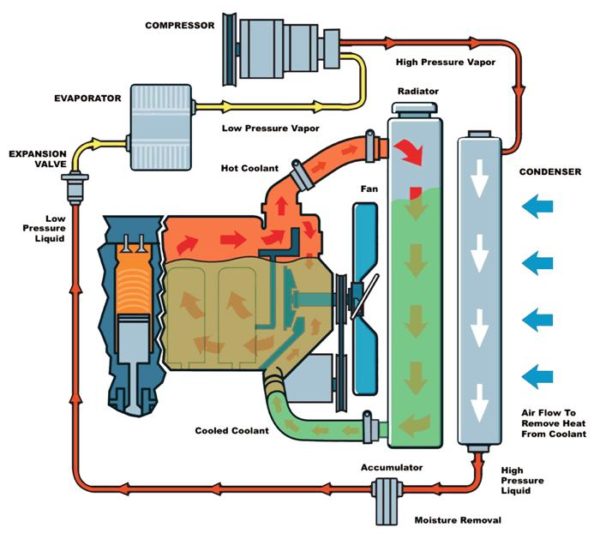Ever wonder what that bubbling liquid in your car's radiator actually does? It's the lifeblood of your engine's cooling system, preventing overheating and ensuring smooth operation. But just like any fluid, it degrades over time. This leads us to the critical question: how often should you flush your car radiator? The answer isn't one-size-fits-all, but understanding the factors involved can save you from costly repairs down the road.
Ignoring your radiator flush schedule is like neglecting to change your oil. While your engine might seem fine initially, the buildup of rust, scale, and contaminants will eventually compromise the cooling system's efficiency. This can lead to overheating, which in turn can cause serious engine damage. Think of a clogged artery – restricted flow leads to major problems. Similarly, a contaminated radiator restricts coolant flow, hindering its ability to dissipate heat effectively.
The history of radiator flushing is intertwined with the evolution of the internal combustion engine. As engines became more powerful, the need for efficient cooling systems grew. Early radiators were simpler, and flushing was less frequent. However, with modern engines and complex coolant formulations, regular radiator flushing has become essential preventative maintenance.
Determining the ideal radiator flush frequency isn't always straightforward. Your car's make and model, the type of coolant used, and your driving habits all play a role. Consult your owner's manual for specific recommendations. Generally, most manufacturers suggest a coolant flush every two to five years or 30,000 to 60,000 miles. Severe driving conditions, like frequent stop-and-go traffic or extreme temperatures, might necessitate more frequent flushing.
Understanding the importance of a radiator flush is key to extending your engine's lifespan. A clean cooling system allows for optimal heat transfer, preventing overheating and protecting critical engine components. It also helps prevent corrosion and the buildup of harmful deposits, ensuring the longevity of your radiator and other cooling system parts.
A radiator flush involves draining the old coolant, flushing the system with a cleaning solution, and refilling it with fresh coolant. This process removes contaminants and restores the coolant's protective properties. For example, if your coolant looks rusty or murky, it's a clear sign that a flush is overdue.
Benefits of regular radiator flushes include: improved engine performance, extended engine life, and prevention of costly repairs. For instance, a clean cooling system allows your engine to operate at its optimal temperature, improving fuel efficiency and reducing emissions.
Create an action plan by scheduling a radiator flush as part of your regular car maintenance. Consult your owner's manual for recommended intervals and consider your driving conditions. Successful car owners understand the importance of preventative maintenance and prioritize tasks like radiator flushes.
Checklist: Check your owner's manual for recommended flush intervals. Inspect your coolant regularly for discoloration or debris. Schedule a radiator flush as needed or according to the recommended schedule.
Advantages and Disadvantages of Frequent Radiator Flushes
| Advantages | Disadvantages |
|---|---|
| Prevents overheating | Cost of the service |
| Extends engine life | Potential for leaks if not done properly |
Best Practice: Always use the correct type of coolant recommended by your car's manufacturer. Don't mix different coolant types. Ensure the system is properly flushed before adding new coolant.
Real Example: A car owner neglected to flush their radiator for years. Eventually, the engine overheated, causing significant damage that required expensive repairs.
Challenge: Difficulty determining the correct flush interval. Solution: Consult your owner's manual and consider your driving conditions.
FAQ: How often should I flush my radiator? Answer: Consult your owner's manual for specific recommendations.
Tip: Inspect your coolant regularly. If it looks rusty or contaminated, it's time for a flush.
In conclusion, understanding how often to flush your car radiator is a critical aspect of responsible car ownership. Regular radiator flushing ensures optimal engine performance, extends engine life, and prevents costly repairs. While it might seem like a minor task, its impact on your vehicle's health is significant. By incorporating radiator flushes into your regular maintenance routine, you're investing in the long-term health and reliability of your car. Don't underestimate the power of preventative maintenance. A simple radiator flush can save you from major headaches and expenses down the road. Take proactive steps today to protect your investment and keep your car running smoothly for years to come. Consult your owner's manual, inspect your coolant regularly, and schedule a radiator flush as needed. Your engine will thank you.
Unlocking potential fc 24 career mode unearthing top wonderkids
The unspoken language of defeat resorting to insults when losing an argument
Unlock your fishing potential mastering garmin echomap uhd 64cv setup
How often should you flush your radiator - Khao Tick On
how often to flush car radiator - Khao Tick On
What Is a Radiator Flush Kit and How Does It Work - Khao Tick On
What Two Cooling System Components Specifically Reduce The Heat Of The - Khao Tick On
Radiator flush The last guide you - Khao Tick On
How Often to Flush Your BMWs Radiator - Khao Tick On
Coolant Flush Euro Car Parts at Thomas Villanueva blog - Khao Tick On
how often to flush car radiator - Khao Tick On
3 Signs Your Car Needs A Coolant Flush - Khao Tick On
How Do I Flush My Radiator - Khao Tick On
When Should You Get Your Radiator Flushed and Why - Khao Tick On
How To Flush Aluminum Radiator at Deborah Berry blog - Khao Tick On
How to Drain and Flush a Radiator and Cooling System - Khao Tick On
How to Flush a Radiator Tips Tricks To Keep Your Engine Running Cool - Khao Tick On
How To Flush Transmission Cooler In Radiator - Khao Tick On














